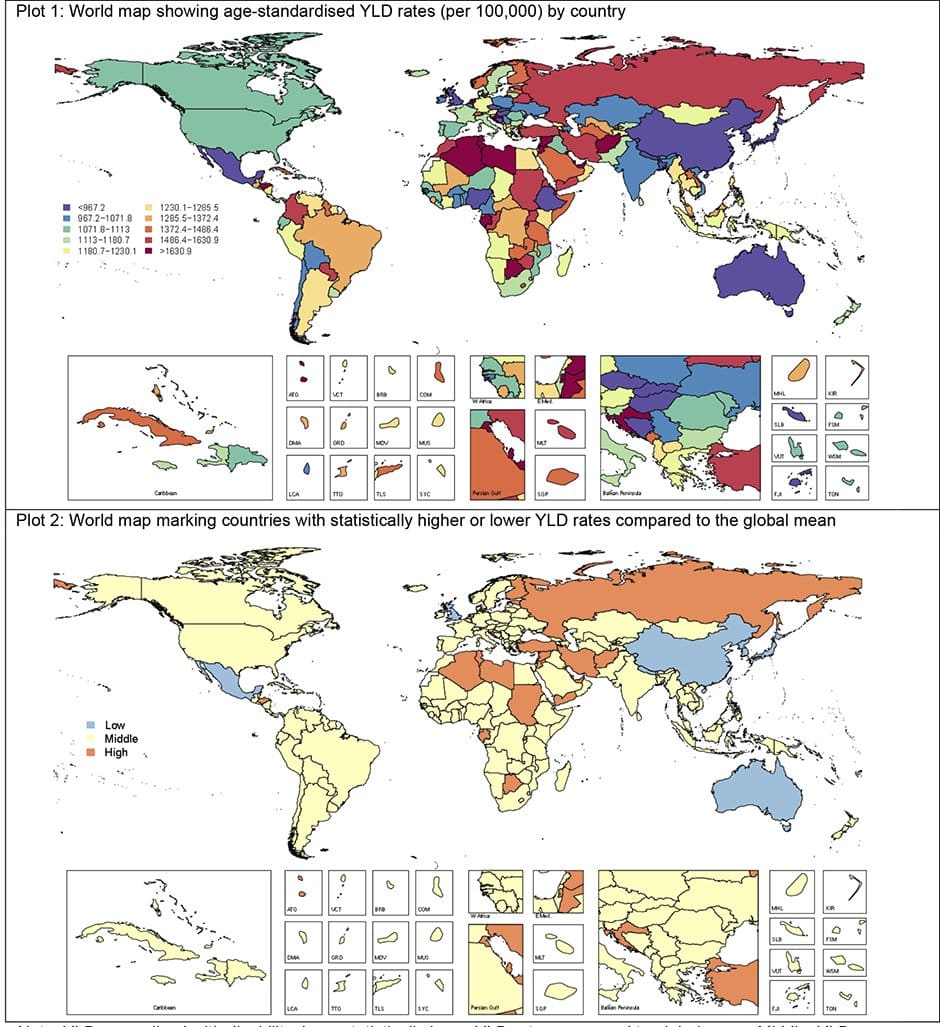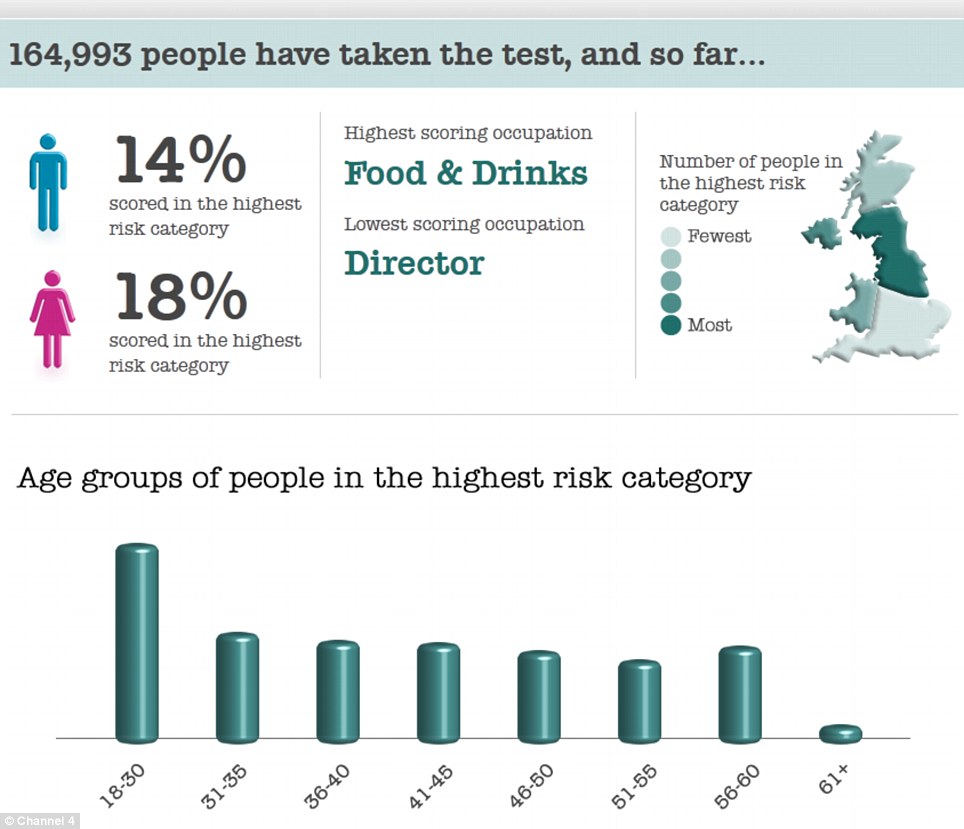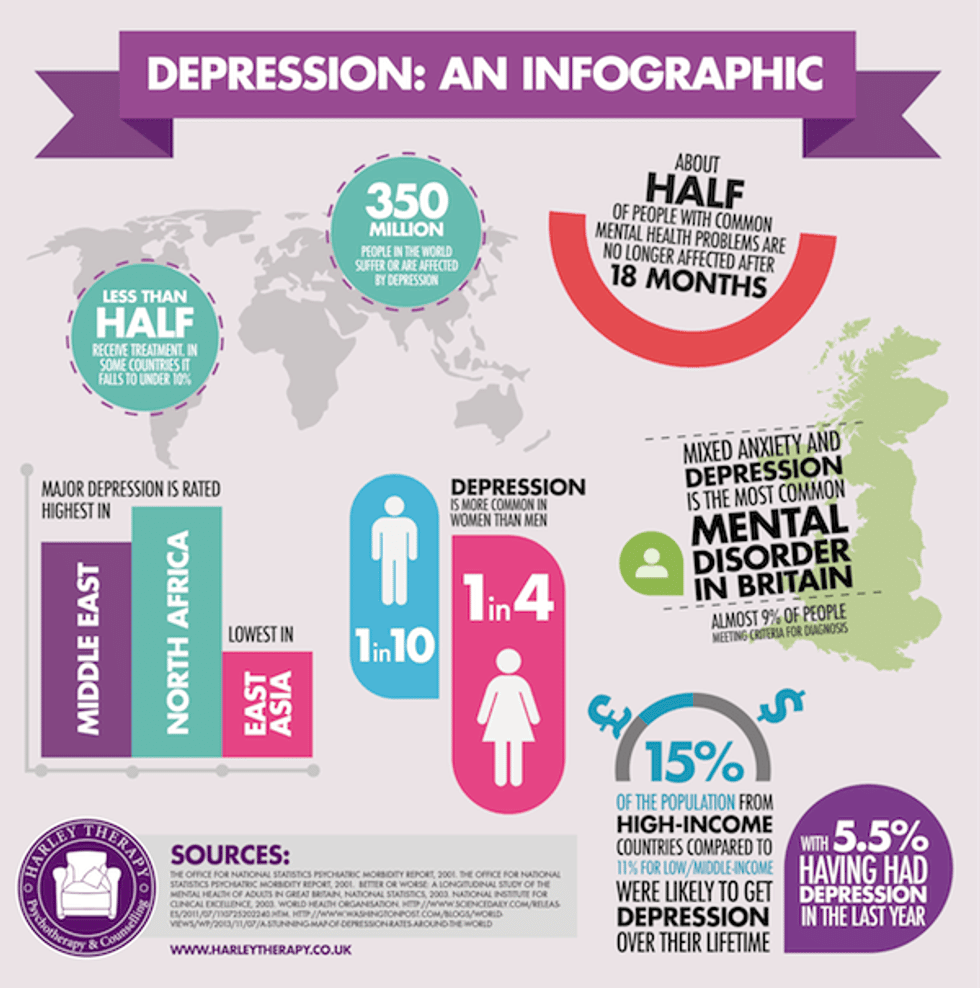Prevalence Of Mental Health And Substance Use Disorders
The predominant focus of this entry is the prevalence and impacts of mental health disorders . However, it is useful as introduction to understand the total prevalence and disease burden which results from the broad IHME and WHO category of mental health and substance use disorders. This category comprises a range of disorders including depression, anxiety, bipolar, eating disorders, schizophrenia, intellectual developmental disability, and alcohol and drug use disorders.
Mental and substance use disorders are common globally
In the map we see that globally, mental and substance use disorders are very common: around 1-in-7 people have one or more mental or substance use disorders.
Prevalence of mental health disorders by disorder type
Its estimated that 970 million people worldwide had a mental or substance use disorder in 2017. The largest number of people had an anxiety disorder, estimated at around 4 percent of the population.
Prevalence of mental health disorders by genders
Nimh Mental Health Statistics By Type Gender And Age
In recent statistics published by the National Institutes of Healths National Institute of Mental Health Disorders, the following findings were highlighted:
- It is not uncommon for people with one mental health disorder to have a second or more coexisting disorder. For example, someone with anxiety, could also suffer from depression along with alcohol and / or substance abuse.
- Across the developed world as well as here in the US, mental health issues appear as many of the leading causes for disability and commonly include
People Suffering From Depression Have A 64% Higher Risk Of Developing Coronary Artery Disease
Additionally, people with coronary artery disease are 59% more likely to have another cardiovascular problem, such as a heart attack, if they also suffer from depression. These statistics on depression indicate an alarming relationship between this mental disorder and coronary artery disease. However, more research is needed to find out whether depression is, in fact, a risk factor for coronary artery disease.
Also Check: How To Treat Chemical Imbalance Depression
About 173 Million Us Adults Experienced At Least One Major Depressive Episode In 2017
Based on these statistics on depression, this number accounted for 7.1% of the US adult population. According to the Diagnostic and Statistical Manual of Mental Disorders, a major depressive episode is defined as a period of at least two weeks when someone feels depressed or shows no interest in daily activities. This will be accompanied by other symptoms related to depression, such as sleep problems, lack of concentration, or low energy levels.
Depression And Suicide Statistics

Suicide is a very well-publicized risk of depression, especially in the most severe cases or major depression. A 2008 study performed by the National Institute on Mental Health found that 3.8% of people surveyed reported that theyd had suicidal thoughts in the previous year.
Similar research found that around two-thirds of people who commit suicide are depressed when they do it. These issues inherently go hand in hand for this reason, but its important to note that most people who suffer from depression arent suicidal.
Also Check: Can Depression Be Cured Permanently
Depression Statistics Everyone Should Know
Steven Gans, MD is board-certified in psychiatry and is an active supervisor, teacher, and mentor at Massachusetts General Hospital.
Depression affects people from all walks of life, no matter their background. It can affect people of all ages as well. Unfortunately, theres still a stigma that surrounds mental health issues, and some people view disorders like depression as a weakness. But, similar to the way anyone can develop certain physical health issues, mental health issues arent always preventable.
Understanding the latest depression statistics could increase awareness about mental health, and recognizing how widespread it is could also help reduce the stigmawhich might encourage more people to seek treatment.
Statistical Methods And Measurement Caveats
Diagnostic Assessment:
Population:
- The entirety of NSDUH respondents for the major depressive episode estimates is the civilian, non-institutionalized population aged 12-17 and 18 years old or older residing within the United States.
- The survey covers residents of households and persons in non-institutional group quarters .
- The survey does not cover persons who, for the entire year, had no fixed address were on active military duty or who resided in institutional group quarters .
- Some adults and adolescents in these excluded categories may have had a major depressive episode in the past year, but they are not accounted for in the NSDUH major depressive episode estimates.
- Sex was recorded by the interviewer.
Interview Response and Completion:
- In 2020, 39.6% of the selected NSDUH sample did not complete the interview.
- Reasons for non-response to interviewing include: refusal to participate respondent unavailable or no one at home and other reasons such as physical/mental incompetence or language barriers .
- Adults and adolescents with major depressive episode may disproportionately fall into these non-response categories. While NSDUH weighting includes non-response adjustments to reduce bias, these adjustments may not fully account for differential non-response by mental illness status.
Data Suppression:
Background on the 2020 NSDUH and the COVID-19 Pandemic:
Recommended Reading: Do I Need To See A Psychiatrist For Depression
Economic Impact Of Depression
- Depression is the leading cause of disability worldwide and is a major contributor to the overall global burden of disease.
- Neuropsychiatric disorders are the leading cause of disability in the U.S. with major depressive disorder being the most common
- Mental Health is the second leading workplace concern, following only family issues.
- Depression contributes to the estimated $100 billion annual cost of depression for U.S. employers, including $44 billion a year in lost productivity alone.
Postpartum Depression Statistics In The Uk
- Similar to the U.S., the number of new mothers in the UK who experience postpartum depression, also called perinatal depression, is around 1 in 10.
- Approximately 1 in 8 British women also experience depression during pregnancy .
- The Royal College of Psychiatrists reports that around 25% of women with postpartum depression still experience symptoms after their new baby turns one.
Don’t Miss: Where Do I Go If I Think I Have Depression
Depression Risk Factors And Treatment Options
Risk factors for depression include: biochemistry , genetics , perrsonality , and environment .
For depression to be diagnosed, symptoms must last at least two weeks. Some medical conditions, such as thyroid problems or vitamin deficiencies, can mimic symptoms of depression and need to be ruled out. Luckily, depression is one of the most treatable mental illnesses, and those who have been diagnosed have multiple options depending on their diagnosis:
- Anti-depressant medication may be prescribed to help correct and/or stablize ones brain chemistry.
- Psychotherapy and/or cognitive behavioral therapy are often used to help individuals work through depression. Therapy is often combined with anti-depressants for moderate to severe depression.
- Electroconvulsive therapy is a medical treatment most commonly used for patients diagnosed with severe depression who have not responded to other treatments. It involves a brief electrical stimulation of the brain while the patient is under anesthesia.
Postpartum Depression Statistics In The Us
While exact postpartum depression rates are unknown, there are some generally agreed-upon figures about the number of women who experience postpartum depression annually.
One recent study found that 1 in 7 women may experience postpartum depression in the year after giving birth. With approximately 4 million live births occurring each year in the United States, this equates to almost 600,000 postpartum depression diagnoses.
Its important to understand that these numbers only account for live births.
Many women who miscarry or have stillbirths experience postpartum depression symptoms as well. When including women who have miscarried or have had a stillbirth, around 900,000 women suffer from postpartum depression annually in the U.S.
Recommended Reading: Does Depression Go Away Completely
Quick Postpartum Depression Facts And Statistics
- Approximately 1 in 10 women will experience postpartum depression after giving birth, with some studies reporting 1 in 7 women.
- Postpartum depression generally lasts 3 to 6 months, however, this varies based on several factors.
- It is estimated that nearly 50% of mothers with postpartum depression are not diagnosed by a health professional.
- 80% of women with postpartum depression will achieve a full recovery.
Depression Affects Over 350 Million People Worldwide

Over 350 million people around the world have depression, according to a report issued by the World Health Organization on World Mental Health Day .
Depression is a mental disorder that undermines peoples ability to function well. However, the stigma associated with the disorder stops millions of people from seeking medical help. Another problem with stigma is that a considerable number of those with depression fail to acknowledge that they are ill.
WHO calls for an end to the stigmatization of depression.
We all have occasional fluctuations in mood depression is completely different. Depression forces the individual into a feeling of sadness that persists for long periods, at least two weeks, according to WHO. It interferes with our ability to function properly at home, school or work.
Fortunately, depression is a treatable illness. Treatments today include medication, psychotherapy, or a combination of the two. Depressed people and those close to them need to become actively involved in addressing the disorder.
Before reaching out for support, it is vital that the depressed person recognizes their disorder. Prompt treatment is best, i.e. the earlier treatment starts, the more effective it tends to be.
Dr Shekhar Saxena, Director of the Department for Mental Health and Substance Abuse, USA, said:
A combination of obstacles stop people from seeking help for depression, such as a lack of proper understanding of the condition and cultural attitudes.
Recommended Reading: How To Go To Work With Depression
Postpartum Depression Statistics In Canada
- Data released in 2019 indicates that 23% of new mothers in Canada experienced symptoms of postpartum depression or anxiety after childbirth.
- Younger mothers ages 25 and below were more likely to develop postpartum depression or anxiety. The prevalence for this group was 30% compared to 23% for other age groups.
- Over 30% of new mothers with postpartum depression or anxiety also had a depressive disorder or mood disorder before pregnancy and delivery.
When Do Covid Blues Become Clinical Depression What Are Some Early Signs
While you are in the thick of things, fighting off viral infection, it is normal to feel tired and headachy. When you feel physiologically terrible, it can interfere with your mood, Dr. Hosey said. I would never diagnose somebody with a clinical depression in the acute phases of a Covid infection.
But if your exhaustion and feeling of being overwhelmed persist for two to six weeks after your Covid infection and start to interfere with day-to-day activities or negatively affect your relationships with others, it could be a sign of depression, Dr. Hosey said.
Some people with depression may also experience persistent sadness, tearfulness, irritability, changes in appetite or weight, trouble thinking or concentrating, or feelings of immense guilt, worthlessness or hopelessness. Those with severe depression may think frequently of death and develop suicidal ideation, Dr. Hosey said.
Don’t Miss: Depression And Other Common Mental Disorders Global Health Estimates
Demographics Of Depression Diagnosis
While the prevalence of depression in the United States is around 6.7%, online mental health awareness publication Verywellmind.com reported in 2019 that 15% of the same population either has or will experience depression at some point during their lives.
According to the same source, the average age of onset for depression is 32.5, but the highest proportion of depressive episodes occurs between the ages of 18 and 25. Its higher in women than men , and its also higher in mixed-race individuals a shocking 11.3% than in people who belong to only one racial group.
Fact: Depression Is A Worldwide Issue
According to the World Health Organization, depression is a major issue throughout the world and one of the most common mental illnesses. People in some countries face specific barriers to getting treatment. These include lack of resources and health professionals trained in mental health. Barriers also include stigma and misdiagnoses, which are common in many countries.
Depression has a big economic and social impact globally. It causes more disability than any other health condition, which means that depression reduces the ability to work in adults and to go to school and perform successfully in young people. Depression causes billions of dollars in lost work hours and productivity throughout the world. Here are some additional statistics about depression around the globe:
- Worldwide, depression is the leading cause of disability.
- More than 300 million people of all ages around the world live with depression.
- Nearly 800,000 people die of suicide around the world each year.
- Less than half of people struggling with depression get treatment.
- In some countries, less than 10 percent get treatment.
- The burden of all mental illnesses, including depression, is increasing.
You May Like: Can Headaches Be A Symptom Of Depression
What Can You Do To Treat Depression After Covid
If you are concerned that you or a loved one may be experiencing symptoms of depression after a Covid infection, its important to talk to a medical or mental health professional. Not everyone will need to see a psychiatrist to be evaluated for depression, Dr. Al-Aly said. People can share what they are going through with their primary care doctor to get help as well, he said. The most important thing is to seek help. And seek help sooner rather than later.
Depression is not something you can typically shake off on your own, Dr. Hosey said. It can be tempting to use online resources and self-diagnostic screening tools and to order supplements that promise to calm Covid-related inflammation or repair your gut health. But many of these interventions are not reliable or backed by evidence.
It is a good idea to take stock of your diet, sleep and drug and alcohol use. Consuming more nutritious foods and setting up a good sleep routine, for example, may have a small positive impact on your mental health. Research suggests that exercise and meditation may also help heal the mind in some cases. But if behavioral changes dont work, a professional can recommend therapy or medication, depending on your needs.
In the wake of a Covid infection, you should give yourself a little bit of a break and be patient, Dr. Hosey said. An infection can be hard to cope with.
Do You Have Depression
If you think you may have depression, its important to not wait and take action as soon as possible.
However, for many people, they are unsure whether or not what they have is temporary and will pass with time or show signs of something more serious that needs treatment.
Getting a diagnosis for major depression will require an assessment from your doctor or mental health professional. Still, if you want to feel a bit more certain about what youre experiencing, you can try taking this free depression test beforehand.
For many people, this gives patients the confidence and drive to act now and start getting the help they need to start living happier and healthier lives.
Additionally, you can also find more tests on various mental health issues, such as anxiety disorders, which tend to coexist with major depression.
Recommended Reading: I M Not Sure If I M Depressed
Life Satisfaction And Mental Health
Is the prevalence of mental health disorders reflected in self-reported life satisfaction or happiness? Overall, evidence suggests that there is a negative correlation between prevalence of particular mental health disorders and self-reported life satisfaction. This suggests that life satisfaction and happiness tends to be lower in individuals experiencing particular mental health disorders.
We discuss the link and evidence for this relationship in our entry on Happiness and Life Satisfaction.
How Is Prevalence Defined And Measured

The widespread issue of underreporting means accurate and representative data on the prevalence of disorders is difficult to define. If relying on mental health diagnoses alone, this underestimation would be severe. Prevalence figures would be likely to reflect healthcare spending rather than giving a representative perspective on differences between countries high-income countries would likely show significantly higher prevalence as a result of more diagnoses.
The data presented in this entry by the Institute of Health Metrics & Evaluation is therefore based on a combination of sources, including medical and national records, epidemiological data, in addition to survey data. Where raw data for a particular country is scarce, epidemiological data and meta-regression models must be used based on available data from neighbouring countries. Data quality issues are described below.
The data presented here therefore offers an estimate of mental health prevalence based on medical, epidemiological data, surveys and meta-regression modelling.
Read Also: Holistic Anxiety And Depression Treatment
What Age Group Has The Highest Rate Of Depression 2020
The highest percentage of adults who experienced any symptoms of depression was found in the 18 to 29 age group, followed by the 45 to 64 age group, and finally the 30 to 44 age group. Mild, moderate, or severe symptoms of depression were more likely to be experienced by women than by men.